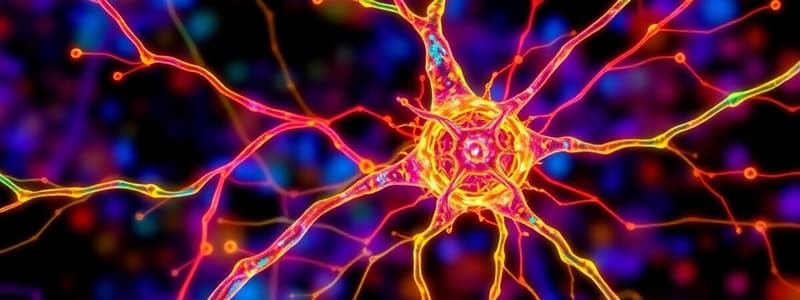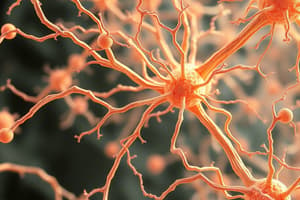Podcast
Questions and Answers
What is the outer diameter of microtubules?
What is the outer diameter of microtubules?
- 50 nm
- 10 nm
- 100 nm
- 25 nm (correct)
Which of the following best describes the primary structural characteristic of intermediate filaments?
Which of the following best describes the primary structural characteristic of intermediate filaments?
- They are hollow and rigid.
- They are short and branched fibers.
- They are flexible tubes made of actin.
- They are ropelike fibers with a diameter of about 10 nm. (correct)
Where are spindle microtubules primarily anchored in a dividing cell?
Where are spindle microtubules primarily anchored in a dividing cell?
- Cytoplasm around cell junctions
- Nuclear lamina
- Microtubule-organizing center (MTOC) (correct)
- Actin cortex
What role do intermediate filaments play in epithelial tissue?
What role do intermediate filaments play in epithelial tissue?
Which is NOT a type of dynamic actin structure mentioned?
Which is NOT a type of dynamic actin structure mentioned?
What is the primary protein that makes up microtubules?
What is the primary protein that makes up microtubules?
What feature distinguishes microtubules from actin filaments regarding their structure?
What feature distinguishes microtubules from actin filaments regarding their structure?
How does the structural rearrangement of large-scale cytoskeletal components occur?
How does the structural rearrangement of large-scale cytoskeletal components occur?
What ratio must be identical at both ends of a simple polymerization reaction?
What ratio must be identical at both ends of a simple polymerization reaction?
How does the hydrolysis of ATP affect actin polymerization?
How does the hydrolysis of ATP affect actin polymerization?
What happens when the concentration of free monomers is greater than the critical concentration?
What happens when the concentration of free monomers is greater than the critical concentration?
Which form of the subunit is typically added to the filament during polymerization?
Which form of the subunit is typically added to the filament during polymerization?
What is the expected behavior of subunits at the minus end of the polymer?
What is the expected behavior of subunits at the minus end of the polymer?
What role do bound nucleotide hydrolysis play in polymerization?
What role do bound nucleotide hydrolysis play in polymerization?
At what point does a polymer grow until?
At what point does a polymer grow until?
What distinguishes the plus end from the minus end in polymer growth?
What distinguishes the plus end from the minus end in polymer growth?
What initiates motility in cells?
What initiates motility in cells?
What structures are primarily involved in the protrusion of the leading edge of a neutrophil?
What structures are primarily involved in the protrusion of the leading edge of a neutrophil?
How does a trimer of actin molecules contribute to filament nucleation?
How does a trimer of actin molecules contribute to filament nucleation?
What mechanism allows neutrophils to quickly change direction while pursuing bacteria?
What mechanism allows neutrophils to quickly change direction while pursuing bacteria?
What occurs during filament nucleation with actin subunits?
What occurs during filament nucleation with actin subunits?
What role do actin filaments play in the shape and movement of cells?
What role do actin filaments play in the shape and movement of cells?
What happens to actin filaments as neutrophils pursue bacteria?
What happens to actin filaments as neutrophils pursue bacteria?
What stabilizes the nucleation process of actin filament formation?
What stabilizes the nucleation process of actin filament formation?
What is the primary reason for the lag phase during the polymerization of tubulin?
What is the primary reason for the lag phase during the polymerization of tubulin?
How can the lag phase in the polymerization of tubulin be altered?
How can the lag phase in the polymerization of tubulin be altered?
Which phase of polymerization corresponds to the equilibrium where addition of monomers balances disassembly?
Which phase of polymerization corresponds to the equilibrium where addition of monomers balances disassembly?
What distinguishes the plus end from the minus end of an actin filament or microtubule?
What distinguishes the plus end from the minus end of an actin filament or microtubule?
What occurs during the lag phase of polymerization?
What occurs during the lag phase of polymerization?
How does the conformation of subunits affect polymerization at the ends of the filament?
How does the conformation of subunits affect polymerization at the ends of the filament?
What is the role of premade nuclei in the polymerization of tubulin?
What is the role of premade nuclei in the polymerization of tubulin?
What happens when the polymerization process reaches an equilibrium phase?
What happens when the polymerization process reaches an equilibrium phase?
Flashcards
Filament Nucleation
Filament Nucleation
The process where actin subunits assemble into a stable structure, forming the initial core for further elongation.
Leading Edge Structures
Leading Edge Structures
The leading edge of a cell, responsible for movement, is comprised of two structures: lamellipodia and filopodia.
Filopodia
Filopodia
Long, thin projections of the cell's plasma membrane, packed with a bundle of actin filaments, involved in cell movement and sensing the environment.
Lamellipodia
Lamellipodia
Signup and view all the flashcards
Minus End
Minus End
Signup and view all the flashcards
Plus End
Plus End
Signup and view all the flashcards
Pseudopod
Pseudopod
Signup and view all the flashcards
Motility
Motility
Signup and view all the flashcards
Nucleation
Nucleation
Signup and view all the flashcards
Growth Phase
Growth Phase
Signup and view all the flashcards
Equilibrium Phase
Equilibrium Phase
Signup and view all the flashcards
Conformational Change
Conformational Change
Signup and view all the flashcards
Premade Nuclei
Premade Nuclei
Signup and view all the flashcards
Lag Phase
Lag Phase
Signup and view all the flashcards
Microtubules
Microtubules
Signup and view all the flashcards
Centrosome
Centrosome
Signup and view all the flashcards
Intermediate Filaments
Intermediate Filaments
Signup and view all the flashcards
Nuclear Lamina
Nuclear Lamina
Signup and view all the flashcards
Cell-Surface Projections
Cell-Surface Projections
Signup and view all the flashcards
Dynamic Nature of Cytoskeleton
Dynamic Nature of Cytoskeleton
Signup and view all the flashcards
Dynamic Structures
Dynamic Structures
Signup and view all the flashcards
Flux of Cytoskeletal Components
Flux of Cytoskeletal Components
Signup and view all the flashcards
Equilibrium Constant (K)
Equilibrium Constant (K)
Signup and view all the flashcards
Critical Concentration (Cc)
Critical Concentration (Cc)
Signup and view all the flashcards
Association Rate Constant (kon)
Association Rate Constant (kon)
Signup and view all the flashcards
Dissociation Rate Constant (koff)
Dissociation Rate Constant (koff)
Signup and view all the flashcards
Nucleotide Hydrolysis
Nucleotide Hydrolysis
Signup and view all the flashcards
Steady State
Steady State
Signup and view all the flashcards
Study Notes
The Cytoskeleton
- Cells require organization in space and interaction with their environment for proper function.
- Cells need a correct shape, structural integrity, and the ability to change shape and move.
- Internal components need to be rearranged as needed (growth, division, adaptation).
- The cytoskeleton, a system of filaments, facilitates these spatial and mechanical functions.
Types of Protein Filaments
- The cytoskeleton's function depends on three main filament families: actin filaments, microtubules, and intermediate filaments.
- Each filament type has distinct mechanical/biological properties and roles, but all share fundamental features.
- These filaments work together to provide strength, shape, and movement capabilities to the cell.
Actin Filaments
- Actin filaments, also known as microfilaments, are helical polymers of the protein actin.
- They have a diameter of 8 nm and can form linear bundles, networks, and gels.
- Actin filaments are highly concentrated in the cell cortex (just beneath the plasma membrane).
- They are involved in cell surface projections (microvilli, filopodia, lamellipodia, and pseudopodia).
- They contribute to cell movement and exploration of its environment.
Microtubules
- Microtubules are long, hollow cylinders (25 nm diameter) made of the protein tubulin.
- They are rigid and straight, frequently attached to a microtubule-organizing center (MTOC) called a centrosome.
- Microtubules play roles in organelle positioning, intracellular transport, and forming the mitotic spindle during cell division.
- Cilia and flagella are also composed of microtubules.
Intermediate Filaments
- Intermediate filaments are rope-like fibers (10 nm diameter) composed of a large family of intermediate filament proteins.
- They form a meshwork within the nucleus (called the nuclear lamina).
- They can span across the cytoplasm providing mechanical strength to cells.
- They can form strong linkages between cells (e.g., skin/epithelium).
Cytoskeletal Filaments: Dynamic Structures
- Large-scale cytoskeletal structures can change or persist according to a cell's needs.
- Macromolecular components of these structures are in a constant state of flux.
- Rearrangement within a cell requires little energy when conditions change.
Cell Division and the Cytoskeleton
- Cells reorganize actin and microtubule filaments during division.
- Actin filaments form contractile rings pinching the cell in two during cytokinesis.
- Microtubule arrays are reorganized into a spindle to separate chromosomes.
Nucleus and Cytoskeleton Interactions
- The nuclear lamina, a meshwork of intermediate filaments, is located just beneath the inner nuclear membrane.
- This structure adds strength and stability to the nucleus.
Nucleation (Rate Limiting Step in Actin Filament Formation)
- Actin subunit assembly into filaments is regulated by nucleation, which is the formation of an initial oligomer or nucleus of subunits.
- The stable nucleus then rapidly elongates by adding more subunits.
- Nucleation is rate limiting, as this initial step determines the overall polymerization rate.
Polymerization On/Off Rates & Critical Concentration (Cc or Kd)
- Subunits are added to and removed from the filament ends at specific rates (kon and koff).
- The rate of addition is proportional to the free subunit concentration (konC).
- Subunits' removal rate is constant (koff) and independent of free subunit concentration.
- Equilibrium occurs when the addition and loss rates are equal, at a constant Critical Concentration.
The Critical Concentration (Cc)
- The critical concentration (Cc or Kd) is the concentration of free subunits at which the rate of subunit addition equals the rate of subunit loss.
- The polymerization of a polymer stops when the concentration of free monomers reaches this critical level.
Time Course of Polymerization
- Polymerization of filaments like actin or microtubules follows a three-phase pattern.
- Lag phase: characterized by initial nucleation steps.
- Growth phase: filaments elongate rapidly.
- Equilibrium phase: rates of addition and loss balance each other.
Plus and Minus Ends
- Filament ends grow at different rates (plus end grows faster than minus end).
- The different rates at which filaments grow on different ends are due to the conformational change of subunits as they enter polymers.
Nucleotide Hydrolysis
- ATP (or GTP) hydrolysis occurs in actin (or tubulin) filaments after monomers associate.
- This process affects filament stability and growth rates.
Accessory Proteins and Motors
- Accessory proteins regulate the length, structure, number, and attachments of filaments and their interactions within the cell.
- These proteins convert information from signaling pathways to cytoskeletal functions enabling various cellular processes including motion.
Studying That Suits You
Use AI to generate personalized quizzes and flashcards to suit your learning preferences.




